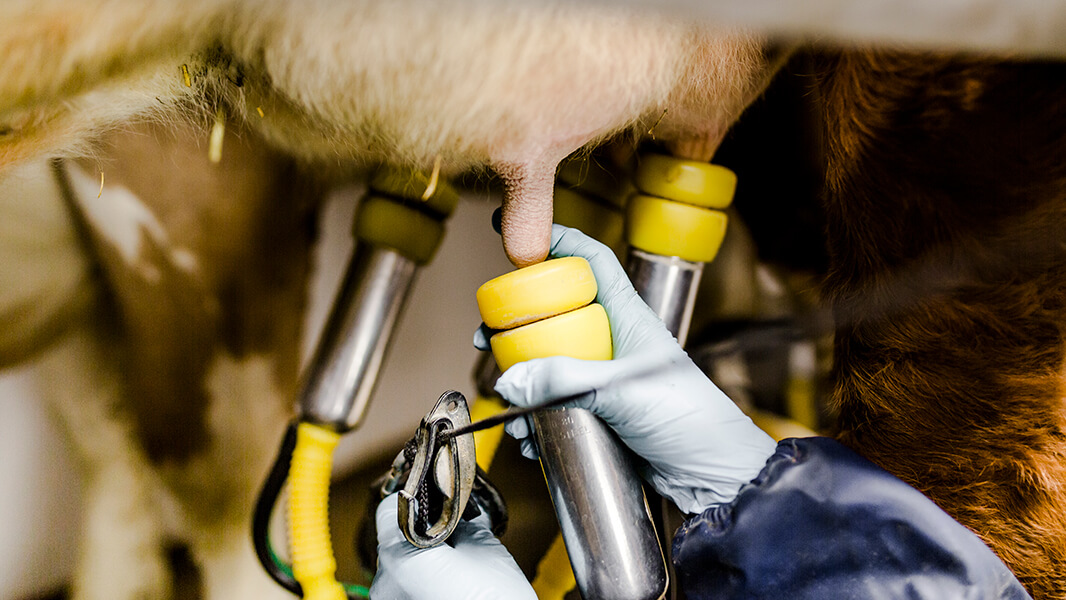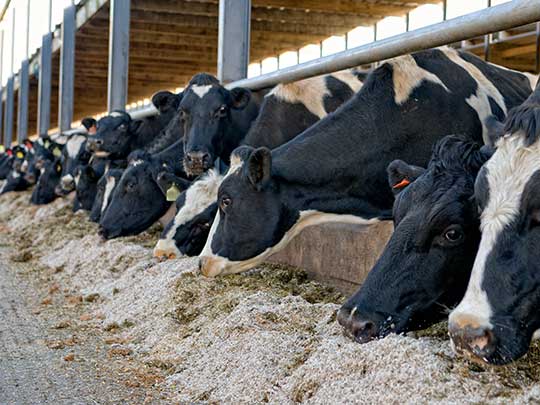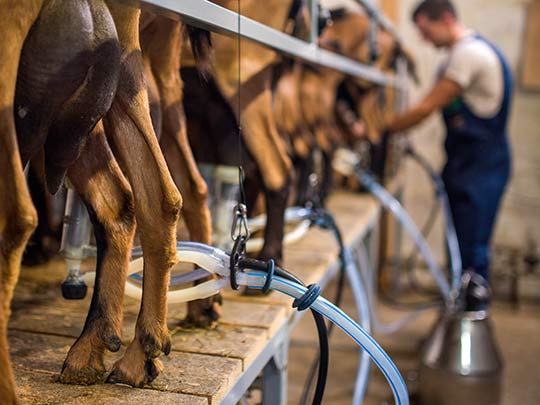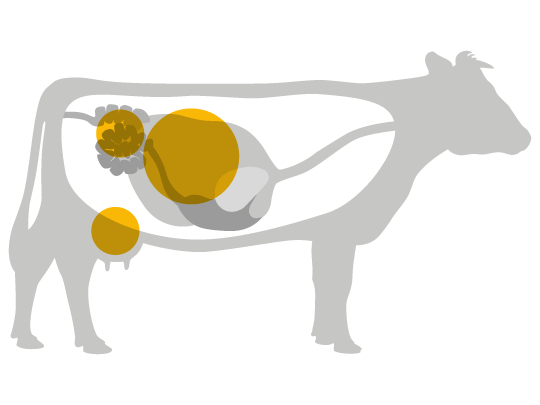
Phytogenics for dairy and beef cattle
Feed efficiency in both large and small ruminant livestock production is a production priority challenging producers, nutritionists, and scientists all over the world. The rising global population comes with an increasing demand for food, especially protein sources such as meat and milk. In recent years the consumption of dairy products alone has increased by more than 2.5% per year globally. The constantly increasing need for animal protein is driving the livestock feed and production industry to provide increasingly efficient, residue-free, sustainable solutions.
Therefore, higher quality and quantity of milk must be produced from the available resources. Higher ruminant energy and protein efficiency are necessary to reach the goal of more milk and meat from the amount of inputs.
Did you know?
A cow that produces approximately 8 gallons of milk a day with 3.3% crude protein (CP) allocates 2.19 pounds of protein to production. Since diets are formulated at around 16% CP for dairy, this cow will consume 7.72 pounds of protein per day. This means that less than 30% of the feed protein is used to produce milk protein. The remaining 70% of protein is used for the animal’s maintenance and metabolic losses.
![[Translate to US:] © DigitalVision /GettyImages](https://www.delacon.com/fileadmin/media/species/Ruminant/Content_ruminant_GettyImages-dv1635024.jpg)
Reduce feed costs by optimizing feed conversion
Enhanced quantity of volatile fatty acids in the rumen and quantity of microbial protein and amino acids flowing to the small intestine can improve growth performance in beef cattle as well as milk yield and quality for dairy animals. However, if the protein or other nutrients supplied to the small intestine for absorption are not digested adequately, a reduction in milk yield and quality, or reduced growth performance in beef cattle can result, leading to decreased performance and loss of profitability.

It is not only the amount of protein that matters
In dairy rations, a consistent supply of high quality protein to the small intestine is essential for top milk yields. However, rations high in undegradable (bypass) protein are often very expensive and if the amount of degradable protein in the ration is not balanced with energy sources, a substantial part of the protein cannot be utilized by the ruminal bacteria leading to an excess of ammonia production. This ammonia, is then converted to urea in the liver, an energy consuming process. Part of this urea is recycled by the animal, but a larger part is excreted either through the milk or the urine.
This situation can lead to high losses of dietary protein, reduced performance, and increased feed costs. When more expensive undegradable protein sources are utilized in ruminant rations, optimizing digestion and absorption is critical for capturing the benefits from the higher input costs.
Did you know?
The metabolic process to reduce the excess urea in the rumen consumes the majority of feed energy. In the long term, this can reduce milk and reproductive performance.

How to support protein efficiency and milk yield in dairy cows?
One method to improve protein utilization is by protecting some sources of protein from microbial fermentation in the rumen to increase the amount of bypass protein available to the small intestine for absorption. Another, less expensive method, is to promote the complete and consistent breakdown of less expensive protein sources in the rumen. Providing a balanced protein and energy supply to the small intestine can improve metabolic efficiency. Thus, advantages in feed costs could be attained by decreasing input costs of by-pass protein sources and using sources rich in ruminal degradable protein.
Looking for other Challenges & Solutions?
Actifor™ Boost – for dairy and beef cattle production

- Optimizes feed intake and thus supports milk yield and milk protein content, as measured in field trials through parameters like milk production, milk solids, and milk urea
- Promotes feed intake and supports energy supply for milk production
- Supports feed intake and supports protein utilization and energy uptake in the ruminant digestive system, as observed in trials
Actifor™ Boost solutions positively adapt feed intake and promote the optimal functionality of the rumen, which was observed through better fermentable organic matter (FOM), and higher VFA production, as well as reduced ammonia in the rumen. This indicates a better microbial protein efficiency. Specific phytogenics like saponins, essential oils and spices in Actifor™ Boost solutions are selected and combined to potentially support the protein utilization which may contribute to increased milk yield and milk protein content while reducing milk urea.
Nature that works
Studies have shown that Actifor™ Boost solutions optimize feed intake and can improve milk yield and quality in dairy cows, as measured through specific milk quality parameters such as milk protein, and milk urea.
| Parameter | Actifor™ Boost Effects |
|---|---|
| Milk yield | +2.43 lb/day |
| Milk protein | +0.04 % |
| Milk urea | -1.34 mg/dL |
Actifor™ Boost solutions maintain desired feed intake and support ruminal production of volatile fatty acids, which helps provide more energy for milk production.
Actifor™ Pro for dairy cattle

- Positively impacts feed intake and contributes to optimize milk production and milk protein content
- While optimizing feed intake contributes to enhanced protein efficiency and therefore may help to reduce feed costs
- By beneficially impacting feed intake helps promote protein efficiency and supports decreasing milk urea concentration
More milk, more meat, more profit. Actifor™ Pro solutions are the phytogenic support for profitable beef and dairy production through optimized feed conversion. The special combination of condensed tannins, essential oils and spice extracts in Actifor™ Pro solutions positively influences feed intake and supports optimized protein utilization throughout the entire gastrointestinal tract of ruminants. The benefits are seen in the milk yield and reduced milk urea from dairy animals and improved rates of gain in beef cattle. Boost the profitability of your operation with the power of nature.
Nature that works
Actifor™ Pro solutions by their ability to optimize feed intake support protein efficacy and help to reduce the amount of milk urea and enhance milk protein content, while simultaneously improving milk yield.
Actifor™ Pro solutions exert beneficial impact on feed intake and have shown to improve protein efficiency.
The study results shown are not intended to represent or guarantee the same or similar results.
Some products are only approved for use in certain geographies, end uses, and/or at certain usage levels. It is the customer's responsibility to determine, for a particular geography, that (i) the product, its use and usage levels; (ii) the customer's product and its use; and (iii) any claims made about the customer's product, all comply with applicable laws and regulations. *Any references to “natural/naturally” are as defined by www.aafco.org. Any references to “feed additive(s)” are as per the laws and regulations in the United States. For product registration information, please refer to the product data sheets.
Get in contact

Megan Koppen
RTM Poultry, Sales Group North America
Phone:
+1 (630) 731-0250
e-mail:
Megan_Koppen@cargill.com